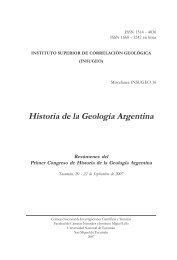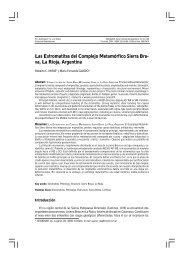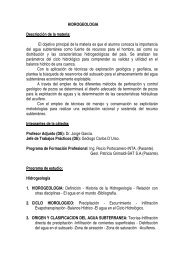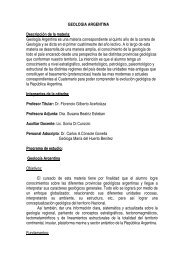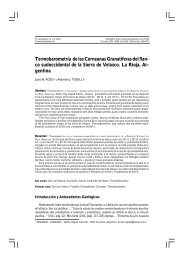Descargue esta publicació en formato pdf haciendo - INSUGEO
Descargue esta publicació en formato pdf haciendo - INSUGEO
Descargue esta publicació en formato pdf haciendo - INSUGEO
Create successful ePaper yourself
Turn your PDF publications into a flip-book with our unique Google optimized e-Paper software.
Serie Correlación Geológica, 28 (2): 85-92<br />
Aportes MAS et al Magmatismo Al. y Metalogénesis Asociada II Tucumán, 2012 - ISSN 1514-4186 - ISSN <strong>en</strong> línea 1666-9479<br />
85<br />
Estudio de inclusiones fluidas de las vetas de cuarzo <strong>en</strong><br />
el granito Rodeo de Los Funes, Sierra de La Ramada,<br />
Tucumán<br />
Graciela MAS 1,2 , Dora L. RUIZ 3 y Julio C. AVILA 3,4<br />
Resum<strong>en</strong>: La zona de estudio está ubicada <strong>en</strong> el faldeo ori<strong>en</strong>tal de la Sierra de La Ramada, la cual, junto con<br />
las Sierras del Campo, el Nogalito y Medina integran las llamadas Sierras del Noreste de Tucumán, pert<strong>en</strong>eci<strong>en</strong>tes<br />
al Sistema de Santa Bárbara. El basam<strong>en</strong>to de la sierra está constituido por filitas y pizarras de la Formación<br />
Medina de edad precámbrica – eocámbrica y el stock granítico de Rodeo de Los Funes de posible edad paleozoica.<br />
Las rocas graníticas son si<strong>en</strong>ogranitos y monzogranitos con alteración hipogénica y supergénica sobreimpu<strong>esta</strong>.<br />
Son portadoras de vetas de cuarzo de hasta 30 cm de espesor. El cuarzo de las vetas pres<strong>en</strong>ta gran cantidad de<br />
inclusiones fluidas (IF). Se determinaron dos tipos: acuosas y acuosas con dióxido de carbono. Las primeras,<br />
bifásicas, son las más abundantes y constituy<strong>en</strong> aproximadam<strong>en</strong>te el 80% de las IF observadas. Por cal<strong>en</strong>tami<strong>en</strong>to<br />
<strong>esta</strong>s inclusiones homog<strong>en</strong>eizan a fase líquida a temperaturas que varían <strong>en</strong>tre 248° y 265°C, con muy escasa<br />
dispersión. Las segundas son inclusiones trifásicas líquidas. Repres<strong>en</strong>tan aproximadam<strong>en</strong>te el 10 - 20% del total de<br />
las inclusiones analizadas. Ti<strong>en</strong><strong>en</strong> temperaturas de homog<strong>en</strong>eización dispersas, pero la mayoría se conc<strong>en</strong>tran <strong>en</strong>tre<br />
240º y 320ºC. Las características de las IF que se han observado <strong>en</strong> <strong>esta</strong>s vetas, son rasgos distintivos de las de los<br />
depósitos d<strong>en</strong>ominados mesotermales de oro o vetas de cuarzo aurífero <strong>en</strong> rocas metamórficas. Se concluye que<br />
las vetas de cuarzo se formaron durante la etapa magmática hidrotermal tardía g<strong>en</strong>éticam<strong>en</strong>te relacionada con el<br />
granito Rodeo del Los Funes.<br />
Abstract: Study of the fluid incluSionS of the quartz-veinS from the rodeo de loS funeS granite, Sierra de<br />
la ramada, tucuman. The study area is located on the eastern flank of the Sierra de La Ramada, which, together<br />
with the sierras del Campo, Nogalito and Medina integrate the Sierras del Noreste de Tucumán, belonging to the<br />
Sistema de Santa Bárbara. The basem<strong>en</strong>t of the range is formed by phyllites and slates of the Medina Formation of<br />
precambrian – eocambrian age and the Rodeo de Los Funes granitic stock of possible palaeozoic age. The granitic<br />
rocks are si<strong>en</strong>ogranites and monzogranites with hipog<strong>en</strong>ic and superg<strong>en</strong>ic alteration. Quartz veins up to 30 cm<br />
of thick are located in the granitic rocks and pres<strong>en</strong>t abundant fluid inclusions (FI). Two types of FI have be<strong>en</strong><br />
determined: aqueous and aqueous with carbon dioxide. The first, two-phase, are the most abundant and constitute<br />
80% of the observed FI approximately. These inclusions homog<strong>en</strong>ize to a liquid phase at temperatures that vary<br />
betwe<strong>en</strong> 248° and 265°C, with very scarce dispersion. The second FI are three phase aqueous inclusions. They<br />
repres<strong>en</strong>t 10 - 20% of the total of the analyzed inclusions approximately. They have dispersed homog<strong>en</strong>isation<br />
temperatures, but most conc<strong>en</strong>trates betwe<strong>en</strong> 240º and 320ºC. The characteristics of the observed FI are distinctive<br />
features of FI in mesothermal deposits of gold or veins of auriferous quartz in metamorphic rocks. It is suggested<br />
that the quartz veins were formed during a late magmatic hydrothermal stage g<strong>en</strong>etically linked to the Rodeo de<br />
Los Funes granite.<br />
Palabras clave: Sierra de La Ramada. Granitos. Vetas de cuarzo. Inclusiones Fluidas.<br />
Key words: Sierra de La Ramada. Granites. Quartz veins. Fluid Inclusions.<br />
1) Universidad Nacional del Sur.<br />
2) CONICET-INGEOSUR. Dpto. Geología (Universidad Nacional del Sur). San Juan 670, (8000) Bahia Blanca,<br />
Arg<strong>en</strong>tina. E-mail: gmas@criba.edu.ar.<br />
3) Universidad Nacional de Tucumán.<br />
4) CONICET-<strong>INSUGEO</strong>. Miguel Lillo 205, San Miguel de Tucuman (4000). E-mail: jcavila@csnat.unt.edu.ar.


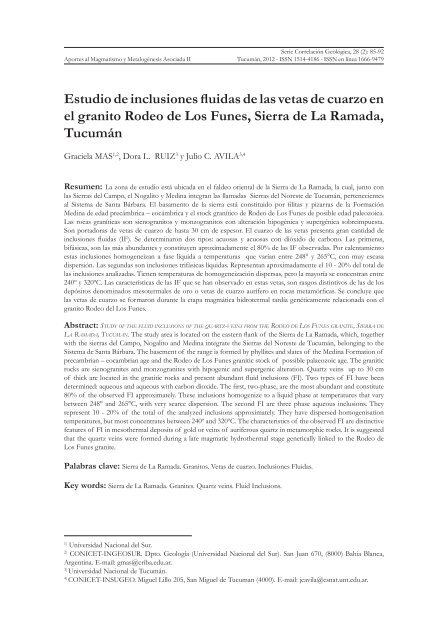
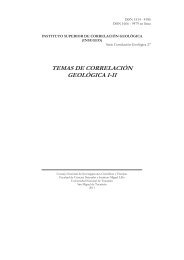
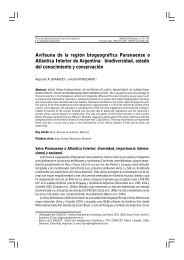

![Descargar El Libro Completo [5.631 Kb] - INSUGEO](https://img.yumpu.com/40710231/1/177x260/descargar-el-libro-completo-5631-kb-insugeo.jpg?quality=85)



